Rainbow Sampler Blanket
06.May.20 / Kirsten BalleringThis is the first part of the Rainbow Sampler Blanket pattern. The pattern has been divided up into 11 parts with photo tutorials, charts and written patterns. You'll find the link to the next part at the end of each post. Enjoy your Sampler journey!
Sampler parts:

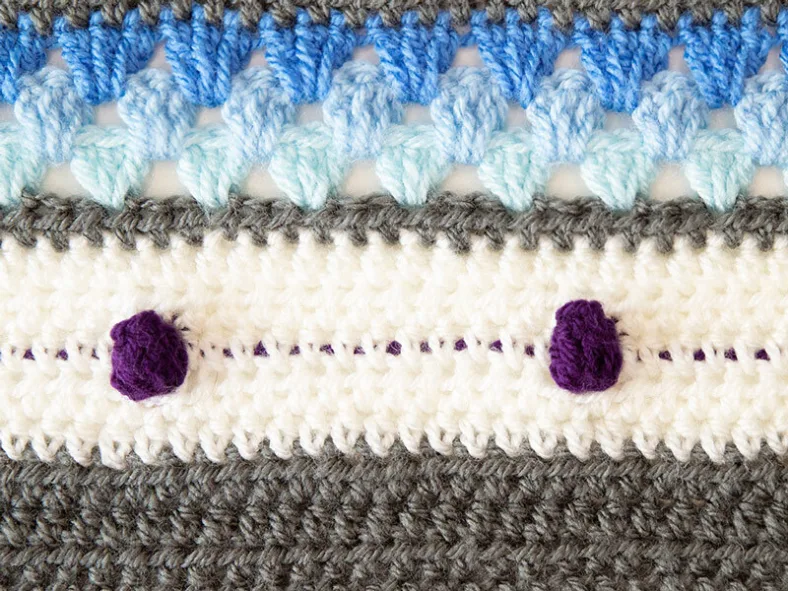
Materials and preparation
Yarn
Rainbow
Scheepjes Colour Crafter (100% Premium Acrylic, 100g/300m)- Colour A: 1063 Rotterdam x 4 balls
- Colour B: 1005 Barneveld x 1 ball
- Colour C: 1425 Deventer x 1 ball
- Colour D: 1034 Urk x 1 ball
- Colour E: 1019 Texel x 1 ball
- Colour F: 1263 Leerdam x 1 ball
- Colour G: 1081 Gouda x 1 ball
- Colour H: 1241 Den Bosch x 1 ball
- Colour I: 1130 Sittard x 1 ball
- Colour J: 1020 Leiden x 1 ball
- Colour K: 1316 Almelo x 1 ball
- Colour L: 1065 Assen x 1 ball
- Colour M: 1132 Leek x 1 ball
- Colour N: 1083 Tilburg x 1 ball
- Colour O: 1123 Roermond x 1 ball
- Colour P: 1067 Hoorn x 1 ball
- Colour Q: 1080 Venlo x 1 ball
- Colour R: 1023 Tiel x 1 ball
- Colour S: 1068 Den Helder x 1 ball
- Colour T: 1009 Utrecht x 1 ball
- Colour U: 1061 Meppel x 1 ball
- Colour V: 1084 Hengelo x 1 ball
- Colour W: 1390 Amersfoort x 1 ball
- Colour X: 1246 Maastricht x 1 ball
- Colour Y: 1708 Alkmaar x 1 ball
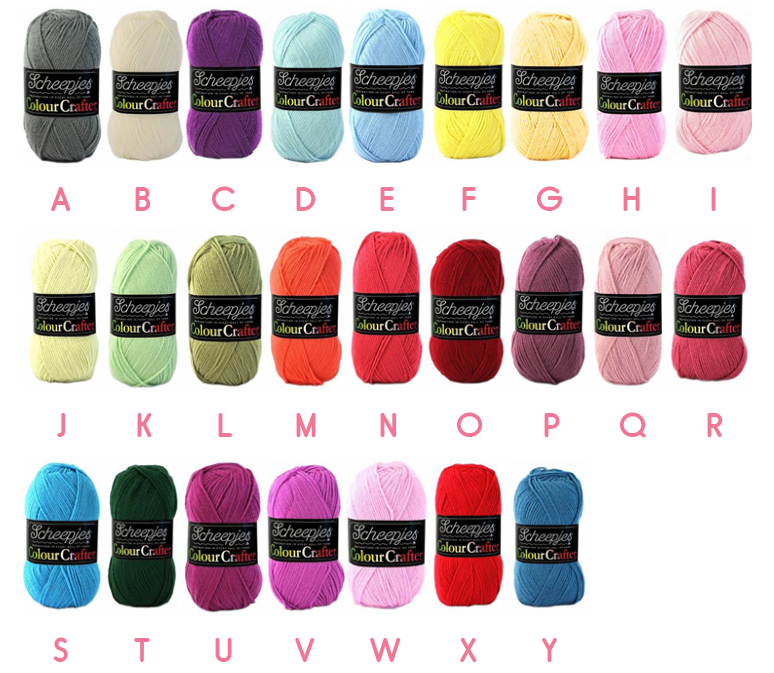
Shop the yarn!
You can find Scheepjes Colour Crafter via your local Scheepjes retailer or order online in these webshops:
Crochet hook
5.0mm (US size H/8), testers worked the blanket on 4.5mm (US size 7).
Measurements
The blanket measures 195 x 190cm (75 x 77in) after blocking.
Gauge/tension
Gauge is not critical for this pattern. It’s cumbersome to match gauge for all the different stitch patterns, and since you’ll be making the blanket in one go you don’t have to worry too much about your tension changing over time. We’ll have enough yarn leftovers to allow for some flexibility. If you want to make sure your blanket measurements are similar to the sample blanket, try to match this gauge: 15 hdc and 11 rows measure 10 x 10cm (4 x 4in) with a 5.0mm hook.
Check your gauge by working a gauge square:
With Colour O, ch26.
Row 1 (RS) Starting in the second chain from hook, work 25hdc, ch1, turn. [25 hdc]
Rows 2-15 25hdc, ch1, turn.
Row 16 25hdc, cut yarn.
Notes
- Yarn amounts used this week are:
- Colour A: 33g
- Colour B: 29g
- Colour C: 7g
- Colour D: 10g
- Colour E: 13g
- Colour Y: 12g
- In most rows you’ll make a ch1 before turning your blanket. This is a turning chain and does not count as a stitch.
- Stitch multiples are given in the tutorials. These are for advanced crocheters adjusting measurements, simply ignore them if you’re following the instructions in this pattern.
- Rather read UK instructions? Check out my UK crochet term conversion chart.
Abbreviations (US terms)
- ch: chain
- dc: double crochet
- hdc: half double crochet
- RS: Right Side
- WS: Wrong side
Repeat formats
- *….; rep from * once/twice/3x Crochet the instructions after * and then repeat that section a further number of times as indicated.
- (…) once/twice/3x Crochet the instructions between brackets the total number of times indicated.
- […] Indicates the amount of stitches at the end of a row or round.
- (…) in same st/sp Indicates that all instructions between brackets are worked in the same stitch or space.
Techniques
Colour change
If you find ‘change colour’ in the instructions, change like this: Crochet the stitch before the colour change until you’ve reached the final yarn over that would finish the stitch. In the case of a hdc, you will now have three loops on your hook. Let the thread of the old colour hang on the backside, and grab the thread of the new colour with your hook (photo 1). Pull the loop of the new colour through your stitch to finish. You have now completed your stitch in the old colour, and you have a loop of the new colour on our hook (photo 2). You can now work your next stitch as instructed.
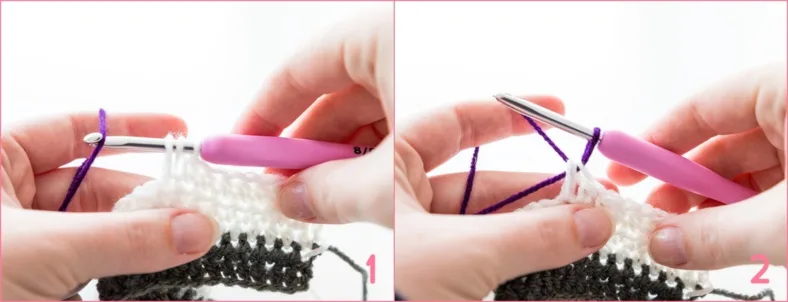
Popcorn with colour change
Click for the tutorial about the Popcorn stitch.
Granny Clusters
Click for the tutorial for Granny Clusters.
Crochet pattern
Starting rows (Rows 1-3)
We’re going to start off easy with a few rounds to get the base of the blanket established.
With Colour A, ch242, turn.
Don’t worry if your starting chain isn’t as long as you would expect. A starting chain stretches a lot, and it will be stretched out by the volume of the stitches that you will crochet in the next rows.
Row 1 (WS) Starting in second ch from hook, 241hdc, ch1, turn. [241 hdc]
Row 2 (RS) 241hdc, ch1, turn. [241 hdc]
Row 3 (WS) Repeat Row 2. Cut yarn. [241 hdc]
Popcorn section 1 (Rows 4-9)
From now on we’ll be trying out all sorts of new stitches so you can add them to your crochet stitch repertoire. Are you ready for your first new stitch? We’re going to make popcorn stitches. Popcorns are stitches that are very visible in your work. They lay on top of your crochet, so they’re not subtle. Especially not when you crochet them in a contrasting colour, such as in this section.
Please note: if you can’t get the colour change right, there’s no shame in crocheting the popcorns in the same colour as the background. I want you to have fun while exploring different stitches, and not be frustrated with the process.
Row 4 (RS) Join Colour B with a ss in first stitch, ch1, 1hdc in same stitch, 240hdc, ch1, turn. [241 hdc]
Row 5 (WS) 241hdc, ch1, turn. [241 hdc]
In the next row, you will crochet hdc’s with Colour B over the purple strand of Colour C and change colour when you crochet a popcorn. It’s to be expected that you see the strand of Colour C through the stitches of Colour B. It’s a dark colour trapped in white stitches, you can’t hide this completely, no matter how hard you try. It will not stand out in the blanket itself, the popcorns are much more interesting!
For detailed instructions on colour changing, see the Techniques section.
Row 6 (RS) 12hdc in Colour B, change colour to C, *1 popcorn in Colour C, change colour to B, 11hdc, change colour to C; repeat from * another 17 times, 1 popcorn with Colour C, change colour to B and cut Colour C, 12hdc in Colour B, ch1, turn. [19 popcorns, 222 hdc]
Do not pull on the purple thread too tight, otherwise you’ll lose stretch in the blanket that other rows do have. This means that your row is smaller and you’ll see this in the end.
Row 7 (WS) 241hdc, ch1, turn. [241 hdc]
Row 8 (RS) 241hdc, cut yarn, turn. [241 hdc]
Row 9 (WS) Join Colour A with a ss in first stitch, ch1, 1hdc in same st, 240hdc, cut yarn, turn. [241 hdc]
Granny Cluster Section 1 (Rows 10-12)
When you learn how to crochet, Granny Squares are probably one of the first patterns you try. These are squares consisting of clusters of 3 double crochets that we call Granny Clusters, and worked in the round. However, this Granny square pattern is easy to adapt to a row-based pattern. It’s both rhythmical and easy to remember. You will work this stitch in multiple sections in this blanket, it's that lovely!
Row 10 (RS) Join Colour D with a ss in first stitch, ch3 (counts as first dc), 1dc in same stitch, *skip 2 stitches, 3dc in next stitch; repeat from * another 78 times, skip 2 stitches, 2dc in last stitch, cut yarn, turn. [79 Granny clusters with 3 dc, 2 clusters with 2 dc, 241 dc in total]
We’ll be working the granny clusters back and forth because the front of the stitch doesn’t differ much from the back. This means that your next row will be worked on the wrong side.
Row 11 (WS) Join Colour E with a ss in first stitch, ch3 (counts as first dc), *3dc in first space between clusters of previous row; repeat from * another 79 times, 1dc in third ch of begin-ch3 of previous row. Cut yarn, turn. [80 Granny clusters with 3 dc, 2 dc, 242 dc in total]
You might have noticed that we have 242 stitches in this row. We’ll fix that shortly.
Row 12 (RS) Join Colour Y with a ss in first stitch, ch3 (counts as first dc), 1dc in first space between clusters, *3dc in next space between clusters; repeat from * another 78 times, 1dc in final space, 1dc in third ch of begin-ch3 of previous row. Cut yarn, turn. [79 Granny clusters with 3 dc, 2 clusters with 2 dc, 241 dc in total]
Row 13 (WS) Join Colour A with a ss in first stitch, ch1, 1hdc in same stitch, 240hdc, cut yarn, turn. [241 hdc]
You’ll find that some stitches stretch more than others, causing your blanket to be a little bit wider than it was after the previous section. Don’t be alarmed, this will be evened out later with the border and with blocking. As long as the blanket looks and feels good, you don’t have to worry.
Continue to the Rainbow Sampler Blanket pattern part 2.
Diagram
Crochet Diagram Week 1
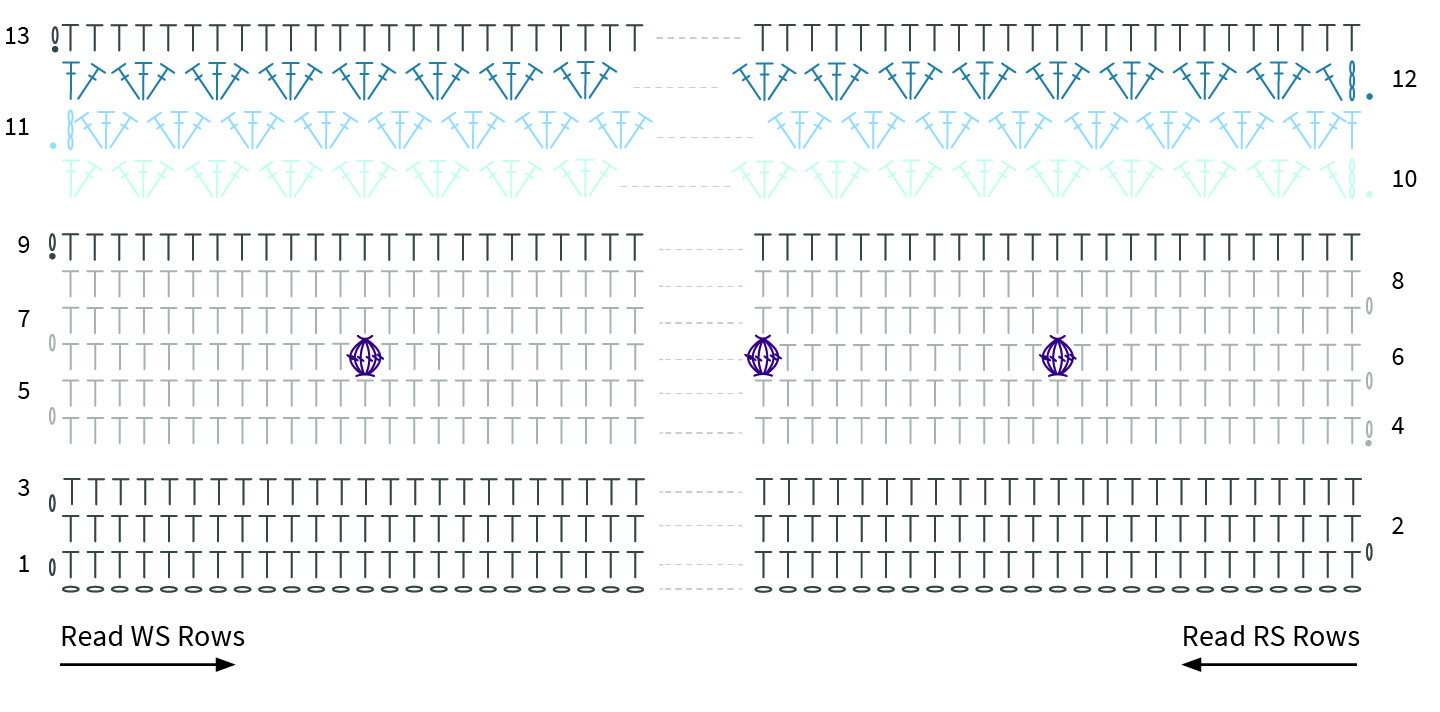
Key week 1
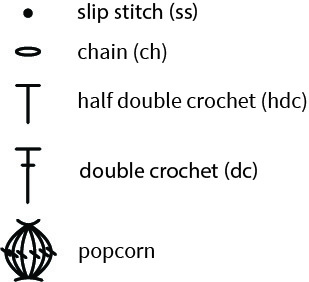
Yarn colours
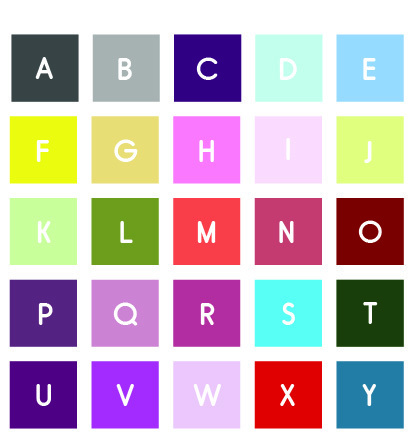




Comments
Cant´t wait for part two!
Thank you so so so much for this! May 12, 2020 15:15 - Reply
exciting plans! If you want to work with fewer colours, it's best to have a look at the colour table below this post, and at the overview photo of the blanket. If you've identified the colours that you want to take out, simple add that yardage to any of the other colours that stay in.
For a lot of colours I don't use more than 50% of a ball of Colour Crafter. So you can simply remove that colour and use another ball of Colour crafter that uses less than 50g for its designated rows to make up for that.
Does that make sense :) ? There are quite a few people in the Haak Maar Raak Community on Facebook that made their own plan colourwise, so I'm sure they can give you some tips on how to approach this as well. The link is in the post above :) July 09, 2020 08:23 - Reply
Looking forward to seeing and doing more of your patterns!
Toni Rumbel July 09, 2020 09:48 - Reply
I know I won't be able to do all of the stitches you have included otherwise it would be oddly long, that's ok, I'll probably pick and choose the ones I like as I go! July 14, 2020 16:19 - Reply
I'm currently making a babysized version in cotton (more about that soon) and I've started with 145 stitches! Thus far, the only fiddly stitches have been the popcorn repeats and the shell repeats. If you keep that in mind, pretty much everything else should fit! July 15, 2020 08:06 - Reply
Thank you July 19, 2020 22:38 - Reply
I'm currently making a babysized version in cotton (more about that soon) and I've started with 145 stitches! Thus far, the only fiddly stitches have been the popcorn repeats and the shell repeats. If you keep that in mind, pretty much everything else should fit! July 20, 2020 08:01 - Reply
yes, this is a US pattern :) July 14, 2021 19:27 - Reply
yes, this is a US pattern :) July 14, 2021 19:27 - Reply
yes, this is a US pattern :) July 14, 2021 19:27 - Reply
yes, this is a US pattern :) July 14, 2021 19:27 - Reply
yes, a slip stitch is a way of fastening the yarn. So you keep your yarn on the other side of the blanket. You insert your hook (without any loops on it) from the right side to the back side, then you pick up the yarn and pull up a loop to the right side. You yarn over, and pull that loop immediately through the loop on your hook (as you would do with a chain).
That fastens your yarn in order to get started with the other stitches, being indeed a chain one to get to the right height and a hdc in the first stitch.
Hope this makes sense! October 21, 2021 13:10 - Reply
het patroon is ook in het Nederlands te vinden! Die vind je hier: https://haakmaarraak.nl/nl/gratis-haakpatroon-regenboog-sampler-deken
Ik verkoop zelf geen garenpakketten, maar er zijn diverse shops die dat wel doen zoals Caro's Atelier. De link daarnaartoe vind je in het patroon onder het kopje 'materialen'! August 03, 2022 07:57 - Reply
Thanks again for offering people this joy to work with!! March 11, 2023 15:50 - Reply
exciting that you're planning to make this blanket! The stitch multiples differ for each stitch, so there's not one multiple that works for all (if there's a stitch multiple, it's mentioned in the tutorial for that particular stitch). The best advice regarding size I have is that you might want to try my baby sampler blanket pattern. It's based on the same base pattern (15 different stitches), but it takes into account that you have less rows if you want to make a smaller blanket. The pattern is here: https://haakmaarraak.nl/baby-rainbow-sampler-blanket
The baby sampler measures around 120 x 90 cm in fingering cotton, so if that's too small for your taste you could also decide to make the baby sampler pattern, but with a thicker yarn (like the aran weight Colour Crafter that's used for the large size sampler). That way, you can up your size without having to change the pattern. Does that make sense? March 11, 2023 16:06 - Reply
I do:
Aster
• Bottle
• Bright pink
• Candy floss
• Citron
• Claret
• Clematis
• Cloud blue
• Cream
• Emperor
• Fondant
• Grape
• Graphite (6 skeins)
• Lavender
• Lemon
• Lipstick
• Magenta
• Meadow
• Pale Rose
• Petrol
• Plum
• Pomegranate
• Raspberry
• Saffron
• Sherbet
• Shrimp
• Spice
• Spring green
• Turquoise January 23, 2024 07:58 - Reply